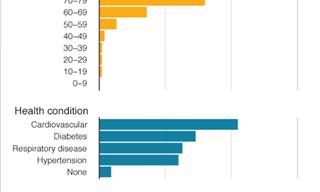Taiwan
The country with the promptest and most successful response to the Novel Coronavirus thread is Taiwan. As of April 6, 2020, there are only 365 cases and 5 COVID-19-related deaths in the country, and this unprecedented success in fighting the SARS-CoV-2 virus is hardly coincidental.
Due to the country’s proximity to China, Taiwan was severely affected by the 2003 SARS epidemic, which also originated in China and spread like wildfire in Taiwan, killing 71 people (making up nearly 10% of the global SARS fatalities). To prevent this from ever happening again, the government of Taiwan created a special epidemiological commission called the Central Epidemic Command Centers, the function of which was to track and deal with any new outbreaks, especially those coming from China. So, the country was pretty much ready for COVID-19, and the first actions towards limiting the outbreak in the country started in January.
The country’s first actions were to restrict entrance to arrivals from Hong Kong and mandate strict 14-day self-quarantine measures to anyone arriving from China. These restrictions seemed excessive at first, but the recent reports suggesting that China may have been downplaying the magnitude of the Novel Coronavirus outbreak put Taiwan’s unusually quick response in perspective. With the spread of the virus, mask-wearing in public spaces was enforced, mass testing was conducted and televised daily briefings by the minister of health Chen Shih-Chung took place and helped raise morale and cooperation in the public. Other information systems were available to the public to ensure prompt diagnosis and quarantine measures.
The combination of all these early measures managed to limit the spread of the disease throughout Taiwan dramatically despite the shared border with China and helped prevent the SARS 2003 scenario from repeating itself.
Germany
The percentage of coronavirus-related deaths in Germany is paradoxically low, only 1.4% compared to at least 10% in surrounding countries like the UK, Spain, and France. Even though there are over 100,000 confirmed cases of COVID-19 in Germany today, the healthcare system is managing to support those affected by the disease. Health officials in the country explain that a combination of fortunate events, mass testing, an abundance of hospital beds, ventilators and other equipment, as well as the country’s quick and organized reaction to the developing crisis, may account for the low death rates.
"The first people that got infected in Germany tended to be younger than the average of the population ... so we were hit later and with younger patients initially," said Karl Lauterbach, a professor of health economics and epidemiology at the University of Cologne, in an interview with CNBC. This delay gave health officials the possibility to observe the development of the disease in younger patients, and they found that there is a "tipping point" at around a week after exhibiting the first symptoms of the disease. Patients with a risk of their lungs failing will typically start to deteriorate at around this time, and tracking the progress of these patients greatly helped to reduce the severity of many cases.
Mass testing is another overarching difference in Germany, with around 350,000 coronavirus tests being conducted every week, which is the largest number of tests in any European country. The tests are conducted whether or not a person is exhibiting any symptoms, too, which helped curb the spread of the disease, as even many asymptomatic patients were sent into quarantine.
Apart from reducing the number of fatalities, it seems like Germany's Coronavirus strategy seems to also work at reducing the number of new patients, as in the past four days, the number of new COVID-19 cases has also started to decline.
South Korea
The response of the public to the governmental restrictions imposed during this time is just as crucial as the restrictions themselves, and in all three countries we've discussed here, the public eagerly followed the lead of the government. In this respect, South Korea is definitely the prime example, as the country proved that a prompt response of the public can help flatten the curve without shutting down the economy.
Like Germany, South Korea has a very low death rate compared to other countries - only 1.4%, with only 186 reported deaths from a total of 10,284 known cases of COVID-19. The first cases of the disease were recorded in January, and only a few weeks later, affordable tests became available throughout the country's pharmacies, and in less than 3 weeks, 46,127 patients were tested.
All in all, the government’s response included the usual steps we also observed in other countries - mass testing, tracking, and treating severe patients, but it was the mobilization of the public and their initiative to cooperate voluntarily that helped reduce the spread of the Coronavirus in the country. In fact, people started practicing social distancing and wore masks even before it was required by the government.
One more difference in the way South Korea reacted to the pandemic is the development of publicly available data collections and GPS-tracking of patients. In fact, there are several apps available in the country that the patients’ anonymous location. "One such app — called the “Corona 100m” — alerted users when they came within 100 meters of the recent whereabouts of a coronavirus patient," says The Diplomat.
Like it is the case with Taiwan, this openness about the location of patients is influenced by previous negative experiences, namely that of the 2015 MERS epidemic that caused mass panic. The government learned from its mistake, and the reaction to the open and democratic approach it exercised this time around is widespread cooperation, which ended up being the defining feature of South Korea's success at managing the current pandemic.
 Go to BabaMail
Go to BabaMail






















































